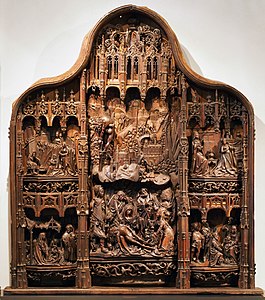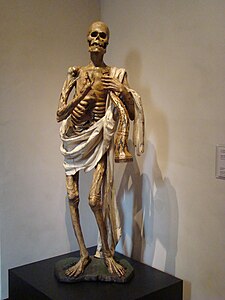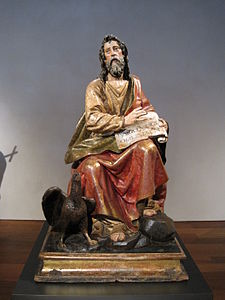
A Holy Week procession is a public ritual march of clergy and penitents which takes place during Holy Week in Christian countries, especially those with a Catholic culture. Various images of the saints, especially the Virgin Mary, and most importantly the image of the crucified Christ are carried aloft by foot on shoulder-borne pasos as an act of penance; acts of mortification are carried out; traditional Christian hymns and chants are sung. In many confraternities of penitents, the faces of the members are covered by elaborate hoods, such as the capirote, as a way of hiding one's identity in order to not ostentatiously draw attention to oneself while performing penance. Crosses, and biers holding Catholic holy images surrounded with flowers and offerings of candles, are carried usually from one parish church to another led by the clergy, monastic orders, or heads of the penitential orders.

The Spanish Renaissance was a movement in Spain, emerging from the Italian Renaissance in Italy during the 14th century, that spread to Spain during the 15th and 16th centuries.

Alonso González de Berruguete was a Spanish painter, sculptor and architect. He is considered to be the most important sculptor of the Spanish Renaissance, and is known for his emotive sculptures depicting religious ecstasy or torment.

The Iglesia conventual de San Pablo or San Pablo de Valladolid is a church and former convent, of Isabelline style, in the city of Valladolid, in Castile and León, Spain. The church was commissioned by Cardinal Juan de Torquemada between 1445 and 1468. It was subsequently extended and refurbished until 1616. Kings Philip II and Philip IV of Spain were baptized in the church, and it was visited by Napoleon. It is one of the buildings considered most emblematic of the city.

Gregorio Fernández was a Spanish Baroque sculptor. He belongs to the Castilian school of sculpture, following the style of other great artists like Alonso Berruguete, Juan de Juni, Pompeyo Leoni, and Juan de Arfe.

The Cathedral of Our Lady of the Assumption and of Saint Fructus is a Roman Catholic cathedral located in the Spanish city of Segovia. The church is dedicated to the Assumption of the Virgin Mary and to Saint Fructus and is the seat of the Diocese of Segovia. It was built in the Flamboyant style, and was dedicated in 1768, constituting one of the latest Gothic cathedrals in Europe.

The Real Monasterio de la Encarnación is a convent of the order of Recollet Augustines located in Madrid, Spain. The institution mainly interned women from noble families, and was founded by the Queen Margaret of Austria, wife of Philip III, and thus was well endowed with wealth. Although it belongs to an enclosed religious order, the building is open to the public under the administration of the Patrimonio Nacional.

The Colegio de San Gregorio is an Isabelline style building located in the city of Valladolid, in Castile and León, Spain, it was formerly a college and now is housing the Museo Nacional de Escultura museum. This building is one of the best examples of the architectural style known as Isabelline, which is the characteristic architectural style of the Crown of Castile region during the Catholic Monarchs' reign.

The Granadan school of sculpture or Granadine school of sculpture—the tradition of Christian religious sculpture in Granada, Andalusia, Spain—began in the 16th century and constituted a clear tradition of its own by the 17th century. The extraordinary artistic activity of Renaissance Granada brought artists to that city from various regions of Spain and from other parts of Europe.

Felipe Bigarny, also known as Felipe Vigarny, Felipe Biguerny or Felipe de Borgoña, etc. and sometimes referred to as El Borgoñón, was a sculptor born in Burgundy (France) but who made his career in Spain and was one of the leading sculptors of the Spanish Renaissance. He was also an architect.

Pedro Roldán (1624–1699) was a Baroque sculptor from Seville, Andalusia, Spain. His daughter Luisa Roldán, known as La Roldana, was also a major figure of Spanish Baroque sculpture.

Antonio de Paz was a sculptor from Salamanca who was born at the end of the 16th century and died in 1647. His work is prominent in Salamanca's churches and cathedral.

Luis Salvador Carmona was a Spanish Baroque sculptor who came from a family of artists.

The Illustrious Penitential Brotherhood of Our Lady of Anguish is a Catholic fraternity established in Valladolid, Castile and León, Spain in 1536.

The Pietà or Sexta Angustia is a work of Baroque sculpture by Gregorio Fernández, housed in the National Museum of Sculpture in Valladolid, Spain. The statue was commissioned by the Illustrious Penitential Brotherhood of Our Lady of Anguish. It is one of the best known of the five sculptures of the same theme by the artist.

The Church of the Monastery of San Benito el Real is a parish church and former Benedictine monastery located in the city of Valladolid, Castile and León, Spain.

Sebastián Ducete was a Spanish sculptor. He was born to the sculptor Pedro Ducete Díez in Toro, Zamora in whose workshop Sebastián collected first experiences. From 1591 on he was trained by the sculptor Juan Sanz de Torrecilla from Palencia. From 1595 to 1598 he worked in one workshop with his uncle Juan Ducete the Younger.

Andrés Amaya was a Spanish Baroque painter in oils of religious subjects. He was active in the region of Castile and León, primarily in the city of Valladolid.

Estofado is an artistic technique that imitates the appearance of gold brocade. The term comes from the Italian "stoffa" (fabric) in reference to the fine textiles it seeks to reproduce. Its origin is found in the Gothic period, its use became more popular during the renaissance and baroque periods, particularly in Spain and its cultural sphere of influence, where it became prevalent. While estofado is mostly used for wooden sculpture, either statuary in the round or reliefs, it is can also be used on other mediums, such as stone sculptures or panel paintings.

The Convent of St. Francis, in Valladolid, Spain, was founded in the 13th century and located outside the city walls, in front of the market square. The convent was protected and sponsored in that century by Doña Violante, wife of King Alfonso X the Wise. Its existence had a great impact on the social and religious life of Valladolid, extending its life until 1836, when it was demolished and its huge plot of land was divided up and put up for sale. From that date, it became part of the lost patrimony of Valladolid.

































































